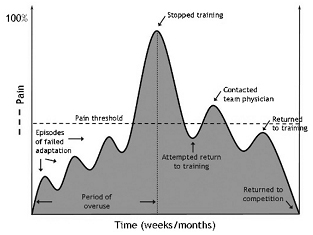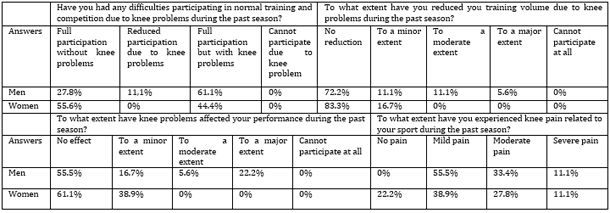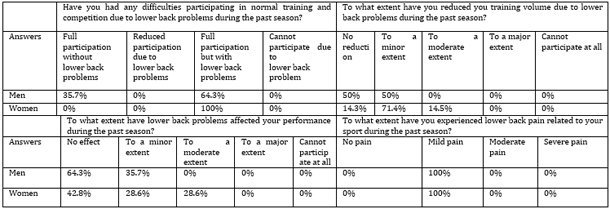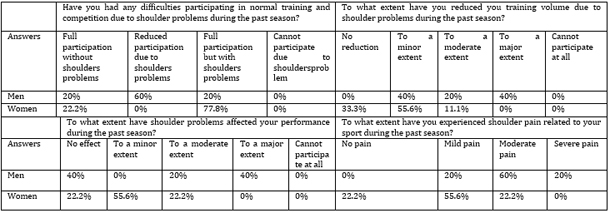|
||||||||||||||||||||||||||||||||||||
| [
Contents
] [ INDEX ]
|
||||||||||||||||||||||||||||||||||||
| UDK 616-001:796.071"2018/2019" COBISS.SR-ID 16478729 |
Page 18 |
|||||||||||||||||||||||||||||||||||
|
Original paper Overuse injuries in young athletes Danilo Višnjevac (1), Vesna Petrović (1), Tanja Rožek Mitrović (1), Slavica Višnjevac (2) (1) COMMUNITY HEALTH CENTRE “DR MILORAD MIKA PAVLOVIĆ” INĐIJA; (2) POLYCLINIC “DR VIŠNJEVAC” INĐIJA |
||||||||||||||||||||||||||||||||||||
|
|
||||||||||||||||||||||||||||||||||||
| Download in pdf format | Summary: In overuse
injuries, there is no clear single event that can be associated with
the injury. They are thought to arise as a result of repeated
submaximal loading of the musculoskeletal system that is not
followed by adequate rest. The aim of the study is to determine the
incidence of overuse injuries in young athletes, their gender
structure and anatomical localization, as well as their impact on
the level of training and competition in the previous season. The
study is based on the analysis of questionnaires completed by
athletes at the end of the 2018/2019 season. The Oslo Sports Trauma
Research Center Overuse Injury Questioner questionnaire was
translated into Serbian and modified to reflect the previous season.
A total of 171 athletes participated, of which 99 (58.1%) were men
and 72 (41.9%) were women. The research involved athletes aged 15 to
30 who competed in 5 sports disciplines: basketball, football,
volleyball, handball and karate. Of the 171 athletes who
participated in the trial, 48.5% registered at least one in the
group of overweight injuries. Of the 99 male athletes, 44.4%
reported injuries. In women, 54.8% of the total were registered in
72. According to anatomical localization, in men, knee injuries were
registered in 4o, 9%, back injuries in 31.8%, injuries in multiple
anatomic locations in 15.9% and shoulder injuries in 11.4%. In
women, knee injuries were reported in 47.1%, shoulder injuries in
23%, back injuries 17.6% and more localization11.8%. Of the men who
reported a knee injury, 61.1% reported having had a lot of
involvement but with knee problems, as well as reduced training. A
little more than half reported that they did not affect performance
during the last season and reported mild knee pain. In the majority
of respondents, they reported full participation without knee
problems and did not reduce the amount of training and that their
knee problems did not affect performance. The highest percentage
reported mild pain. In male subjects with lower back injury, the
highest percentage, 64.3%, reported full participation, but with
problems, half reduced training. In the largest percentage, 64.4%
had no effect on performance during the previous season and all
subjects reported mild pain. All the respondents answered that they
had full participation but with problems in the lower back. The
largest 71.4% reduced training volume to a lesser extent, while
42.8% said the lower back problem did not affect performance during
the previous season and all reported mild pain. Questions about
shoulder problems the majority of male respondents, 60%, said they
had reduced participation due to shoulder problems. An equal
percentage of 40% reported that they had reduced their training
volume to a lesser extent and generally decreased it. More than
half, 60% reported having a shoulder problem that affected
performance, and all respondents reported some level of shoulder
pain. Also, the largest number of female respondents, 77.8%,
reported full participation but with shoulder problems, decreased
training and affected performance during last season. The highest
percentage reported some level of pain. In our research, some of the injuries caused by overstress were registered in almost half of the respondents, 48.5%. Injuries are more commonly reported in female subjects. In both groups of subjects, knee was the most common anatomical localization Keywords: sport’s overuse, sport’s injuries, young athletes |
|||||||||||||||||||||||||||||||||||
| INTRODUCTION: The participation of young people in sports and regular physical activity offers many benefits: improving general health, socializing with peers, increasing self-esteem. Regular physical activity and sports have been widely promoted due to its many positive effects. Contributes to improving the function of the cardiovascular system, has a positive effect on the development of the nervous and muscular systems, reduces anxiety [1,2,3,4,5]. Although children and young people should be encouraged to participate in a number of different sports activities and develop different skills, it is increasingly common today for young athletes to participate in only one sport and the so-called "early specialization" in sports, which often ends before the end of primary school. Young people, like their parents, start with high intensity training from the desire to participate in elite leagues, get scholarships and the like. All this leads to more frequent injuries in sports. A large number of participants in sports activities have led to sports being the primary cause of injury in young people [1,6,7]. Today, sports injuries are most often divided into acute (traumatic) and overuse injuries. Traumatic injuries are the result of a specific event, which can be identified. In overuse injuries, there is no single individual event that can be associated with the injury. Overuse injuries are thought to result from repeated submaximal loading of the musculoskeletal system that is not followed by adequate rest. These are repetitive microtrauma resulting from repeated exposure to force or a large number of repetitions. In most cases, the tissue recovers at the beginning of the process without visible signs and symptoms, however as the process continues the possibility of adaptation is depleted and results in clinically clear symptoms [1,4,8,9,10,11,12,13]. Figure 1 Figure 1. Hypothetical overview of the onset of tissue injury and pain in a typical overuse injury. Adopted from R. Bahra. No injuries, but plenty of pain?On the methodology for recording overuse symptoms in sports. Br J Sports Med 2009;43:966–972. doi:10.1136/bjsm.2009.066936
Overuse injuries are considered to be one of the most common
etiological factors leading to injuries in young athletes, and that
almost half of sports injuries in children and young people belong
to overuse injuries. Overuse injuries can affect: bones, muscles,
tendons, ligament. There are several risk factors for the occurrence
of an overuse injuries as: previous injury, adolescent age, higher
training intensity, etc. Overuse injuries are considered to be
underestimated in the literature because the majority of studies
define injuries based on time off from competition. While more
recent studies have cited the term "presence of any physical
discomfort", and above all pain, which has led to a significantly
higher number of reported overuse injuries [1,8,9,12,13]. However,
there are also works that indicate that the term overuse injuriesis
used too often and advise that it should be avoided until there is
definitive evidence of a cause of injury. Overuse injuries most
commonly affect the knee, shoulder, and lower back
[10,11,13,14,15,16] . The importance of regular monitoring and
protection of the health of athletes is increasingly recognized. For
this reason, several systems for reporting and monitoring illnesses
and injuries in athletes have been developed. Since 2008, the
International Olympic Committee has also developed an injury
monitoring system. The first official guidelines were for reporting
and monitoring injuries in football, and later they formed the basis
for other sports. Nowadays, a questionnaire developed in 2013 to
register overuse injuries is increasingly used. The Oslo Sports
Trauma Research Center Overuse Injury Questioner has 4 key questions
and a response and scoring system. The questionnaire collected data
based on whether the athletes experienced / felt pain, limited
participation in training or competition, and reduced training or
competition volume [2,8,10,15,16,17,]. Table 1. Replies regarding overuse knee injuries In men with lower back injury, 35.7% (5) reported full participation in training or competition with no problems in the lower back, 64.3% (9) reported full participation but with problems in the lower back. until reduced participation was reported. 50% (7) did not reduce the volume of training due to lower back problems, 50% (7) reduced it to a lesser extent, no moderate or major response. Respondents in 64.4% (9) answered that lower back problems did not affect performance during the last season, 35.7% (5) responded that they were less affected while there was no response that they were more affected. Subjects who had a problem in the lower back reported mild pain. In women, all respondents said that they had full participation in training or competition but with problems in the lower back. Of these, 14.3% (1) replied that the problem in the lower back did not affect the decrease in training volume, 71.4% (5) reduced it to a lesser extent, 14.3% (1) moderately decreased until it was more extensive. When asked about the extent to which lower back problems affected their performance, over the past season, 42.8% (3) answered that it was unaffected, 28.6% (2) to a lesser extent and 28.6% (2) to a moderate extent while there was no greater response. All respondents answered that they experienced mild lower back pain related to sports. (Table 2.) Table 2. Replies regarding overuse lower back
overuse injuries To questions about shoulder problems, during last season, of the
total number of male respondents, 20% (1) answered that they had a
full participation in training or competition without shoulder
problems, 20% (1) a full participation but with problems with
shoulder and 60% (3) responded that he had reduced involvement due
to shoulder problems. None of the respondents answered that they did
not reduce the volume of training due to shoulder problems. 40% (2)
of the respondents reported that they reduced the training volume to
a lesser extent, 20% (1) moderately and 40% (2) mostly reduced the
training volume. 40% (2) of the respondents answered that the
shoulder problem did not affect the performance during the last
season, there was no answer to a lesser extent, 20% (1) and mostly
40% (2) answered moderately. None of the respondents answered that
they did not have shoulder pain, 20% (1) reported mild pain, while
moderate sport-related shoulder pain was reported in 60% (3) of the
subjects and 20% (1) severe pain. Table 3. Replies regarding overuse shoulder
overuse injuries Discussion. It is estimated that 50% of sports injuries in
children and young people are related to overuse injuries. However,
detailed analysis and data on overuse injuries in children and young
athletes are lacking, but in the opinion of athletes and coaches
overuse injuries are very common. Young athletes are more at risk of
developing overuse injuries than older athletes. There are several
reasons for this: bone mineralization, cartilage development,
immaturity of the musculoskeletal system, a sudden increase in
training efforts, but also a lack of awareness of overuse injuries
in young athletes [1,4,11,13,16]. In our study, 171 subjects
participated, most of them men. Respondents are of different age
groups, including sports experience, and have participated in 5
sports disciplines. This is important since it is known that overuse
injuries may differ depending on the age and type of sport [1]. Of
the total number of respondents, 48.5% reported at least one in the
overuse injuries group. The literature data differ in part from the
fact that the average prevalence of all overuse injuries is 39% to
46.2% of those who reported an injury [7,16]. A higher number of
overuse injuries was registered in women than in men, 54.8% compared
to 44.4%. This is consistent with literature data that overuse
injuries are more common in female than male. It is also stated that
not only are overuse injuries more common but also occur earlier
[11,13]. In men and women, the most common overuse injuries were
knee injuries, which, like the total number of overuse injuries,
were more common in women with 47.1%. This corresponds to literature
data that indicate that the lower extremities are more commonly
injured. Most overuse injuries are considered to include the knee,
and this percentage ranges from 35% to 52%. It is also stated that
overuse injuries knees are common in many different sports
[3,10,13].
|
||||||||||||||||||||||||||||||||||||
|
REFERENCES:
|
||||||||||||||||||||||||||||||||||||
|
|
||||||||||||||||||||||||||||||||||||
|
Corresponding Address: Danilo Višnjevac, Dom Zdravlja “Dr Milorad Mika Pavlović” Inđija E-mail: visnjevac.danilo@yahoo.com |
Paper received: 2.2.2020 Paper Internet issues: 30.6.2020 |
|||||||||||||||||||||||||||||||||||
| [
Contents
] [ INDEX ]
|
||||||||||||||||||||||||||||||||||||
|
||||||||||||||||||||||||||||||||||||




